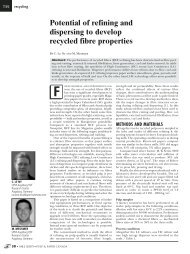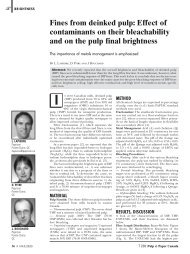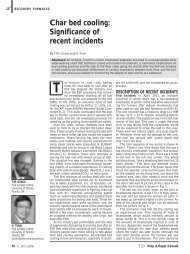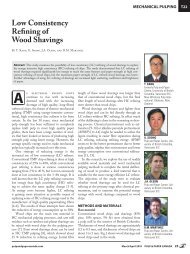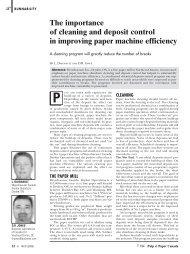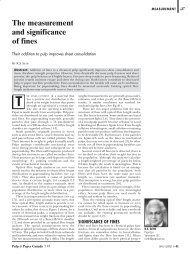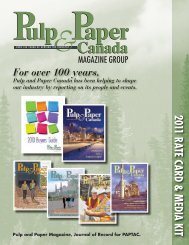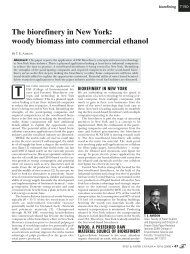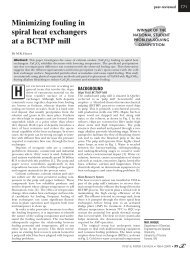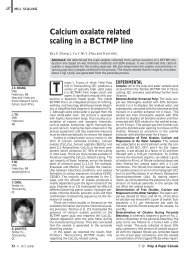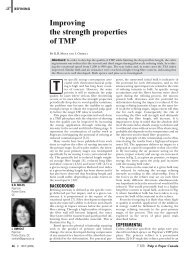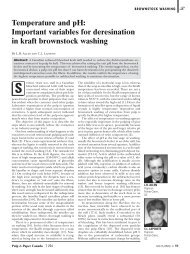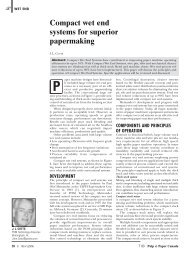Mill increases production capacity through automation and simple ...
Mill increases production capacity through automation and simple ...
Mill increases production capacity through automation and simple ...
Create successful ePaper yourself
Turn your PDF publications into a flip-book with our unique Google optimized e-Paper software.
sustainabilityT30<strong>Mill</strong> <strong>increases</strong> <strong>production</strong> <strong>capacity</strong><strong>through</strong> <strong>automation</strong> <strong>and</strong> <strong>simple</strong>process changesBy J. HOWELL, T. WESSLEN AND D. R. FARRARAbstract: Due to severe market pressures <strong>and</strong> economies of scale, this paper describes several projectsthat focused on increasing the maximum sustainable rate (MSR) of a northern bleached hardwoodkraft mill. Through <strong>automation</strong>, <strong>simple</strong> process improvements, <strong>and</strong> a willing workforce, themill achieved a 9.3% MSR increase.V NACKAWIC INC. is currently a northernbleached hardwood kraft mill.AThe mill was built on the St. John RiverValley in 1970 <strong>and</strong> averaged 600ADMT/day during the first decade. Itwas a typical size for the time it was built. From1998 to 2000 the mill averaged 723 ADMT/daywith a maximum sustainable rate (MSR) of 798ADMT/day. Modern mills are over four times this<strong>capacity</strong>. This gives a tremendous manufacturingcost advantage <strong>through</strong> the economies of scale.In order to try <strong>and</strong> survive the market pressuresfrom increased world <strong>capacity</strong> <strong>and</strong> marketdem<strong>and</strong>, the mill focused on reducing manufacturingcosts. One of the most cost-effectiveapproaches to reducing manufacturing costs is toincrease <strong>production</strong>. By increasing <strong>production</strong>,there is a directed reduction in fixed cost pertonne. This paper describes the projects in thefiberline area that helped achieve a 9.3% MSRincrease.The maximum sustainable rate (MSR) isdefined as the 90 th percentile of all scheduleddaily <strong>production</strong>. Or, if the mill maintains anoverall <strong>production</strong> efficiency of 90%, it couldconsistently achieve the MSR. Figure 1 ranks the<strong>production</strong> days from highest to lowest <strong>and</strong> iscalled the <strong>production</strong> duration curve. The MSR,which is the 90 th percentile position, for 2003 was872 ADMT/day.From 2001 to 2003, five significant fiberlineprojects have contributed to a large MSR increaseof the mill.PROJECT I: PULP MACHINE DCSIMPLEMENTATIONIn the fall of 2000, the stock preparation <strong>and</strong> wetend of the pulp machine was converted from panelbased control to a Distributed Control System(DCS). With better process control, the MSR ofthe machine was increased by 1.9% despite thereduction of operational manpower. The DCStransition went extremely well <strong>and</strong> one of theadditional benefits besides increased <strong>production</strong><strong>capacity</strong> was the increased flow of information.The graphical-based interface greatly improvedthe knowledge of the process for everyone. A pictureis truly worth a 1000 words as shown in Fig.2. It has allowed easier training of operators <strong>and</strong>has increased troubleshooting abilities. The DCSwas the stepping-stone for what the mill was aboutto achieve.PROJECT II: PULP MACHINE1ST PRESS STEAM SHOWERThe drying <strong>capacity</strong> of the pulp machine area wasthe bottleneck (rate limiting step) of the mill. Anextensive study was done to determine whatcould be done to increase pulp machine <strong>production</strong>.It was determined that the press section wasJ. HOWELL,Fibre Line ManagerAV Nackawic Inc.Nackawic, N.B.T. WESSLEN,Pulp & Paper ApplicationConsultant Technical,Industry, ProposalGroup (TIP) N.A.Invensys, 250 Scientific Drive,Suite 400Norcross, GA 30092FIG. 1. Production duration curve.D. R. FARRAR,Fiber Line Controls ConsultantInvensys PerformanceSolutions (IPS)33 Commercial St.Foxboro, Ma. 02035PULP & PAPER CANADA • 108:2 (2007) • 33
T31sustainabilitynot giving good performance despite havinga couch consistency of 30%. The pressconfiguration is shown in Fig. 3.In January 2002, a steam shower wasinstalled on the entering nip of the 1stpress. Fig. 4 shows the temperatureincrease of the pulp sheet before <strong>and</strong> afterthe installation. This allowed the moistureFIG. 2. Pulp machine DCS graphic.removal efficiency of each press toincrease <strong>and</strong> allowed a <strong>production</strong>increase of 4.6%! It is well documentedon how this steam shower works <strong>and</strong> thetheory behind it [1,2,3]. The return ofinvestment for this particular project wasapproximately one week. The steam showeralong with the other projects in themachine room allowed us to break ourdaily <strong>production</strong> record 14 times, break amonthly record, <strong>and</strong> break a yearly totalrecord in 2002.PROJECT III: BLEACH PLANTVACUUM WASHERPERFORMANCESince the pulp machine could “out run” therest of the mill at will, the bleach plantbecame the next bottleneck. The reliabilityof the bleach plant washers were limitingthe bleach plant <strong>production</strong> rate. At the endof 2002, a task force was created to solve thespecific mechanical failures of the vacuumdrum washers. In particular, the inflatableEPDM (Ethylene Propylene DieneMonomer) rubber tubes were failing prematurely,as shown in Fig. 5, causing significantdowntime <strong>and</strong> maintenance resources.Figure 6 illustrates how the tube seal<strong>and</strong> PTFE (PolyTetraFluoroEthylene)packing create a seal between atmosphericpressure <strong>and</strong> the vacuum chamber. Thevacuum is generated by the filtrate flowfrom the washer deck <strong>through</strong> the dropleg piping. The purpose of the water filledEPDM tube seal is to apply a constant,even pressure to the PTFE packing aroundthe circumference of the rotating drum.After visiting other mills <strong>and</strong> analyzingeach installation, the task force solved theproblem in January of 2002. Even thoughwe had supplier specified pressure in theFIG. 3. Pulp machine press section.FIG. 4. 1st press steam shower.FIG. 5. EPDM tube seal failure.FIG. 6. Bleach washer tube seal & packing.34 • 108:2 (2007) • PULP & PAPER CANADA
sustainabilityT32tube seals, there was little flow. The originaldesign of the tube seal water returnpiping did not allow proper flow. The rubbertube seals were “cooking” due to insufficientcooling. By letting the dischargerun unrestricted, the mill could easilycheck for proper flow <strong>and</strong> temperature.After obtaining proper cooling (below65°C) as well as pressure (12 psig), theChips & Liquortube seal life on the D1 washer increasedfrom an average of two months to sevenmonths! The majority of the washers areachieving over 12 months tube seal life!This allowed the maximum <strong>production</strong>rate of the bleach plant to increase from850 to 925 ADMT/day. The operators feelthat they could even go higher if the stockwas available.PROJECT IV: DIGESTERCONTROL OPTIMIZATIONAfter the large increase in <strong>production</strong><strong>capacity</strong> of the pulp machine <strong>and</strong> bleachplant, the digester rate was being challenged.Several options were analyzed toincrease the <strong>capacity</strong> of the digester system;steam packing, an additional digester,PTTTTBlowFIG. 7.SteamFIG. 8. Digester DCS graphic.FIG. 9. Digester cooking temperature variability.FIG. 10. Digester reblow frequency.FIG. 11. Digester steam use variability.FIG. 12. Digester steam check valve life.PULP & PAPER CANADA • 108:2 (2007) • 35
T33sustainabilityFIG. 13. Individual digester yield.scheduling. One of the graphics is shownin Fig. 8.In April 2003, the digesters were convertedfrom pressure control to temperaturecontrol. The conversion wentextremely well with no problems. Insteadof using the pressure of the digester tocontrol the steam valve, the average temperature(bottom, mid, top) is used. Theprogram automatically adjusts the finaltemperature target (within constraints of165°C to 175°C) depending on thedigester schedule. For example, if thedigesters have time (slower <strong>production</strong>rate), the final temperature will be lowerthereby saving steam, increasing yield,uniformity, etc. Conversely, at higher <strong>production</strong>rates, the final temperature willapproach 175°C to meet the blow timetarget. This allows “catch-up” ability if thedigesters are behind schedule. The resultswere immediate. Digester cooking temperaturevariability was reduced by 43%,as shown in Fig. 9.Where %variability is defined by:% Variability = 2 — 100 = –2 St<strong>and</strong>ardDeviation—————————— 100 (1)AverageFIG. 14. Pulp machine dryer DCS graphic.FIG. 15. Overall maximum sustainable rate.Another indication of improved cookingwas the reduction of non-uniform cooksby over 50%. Non-uniform cooks or“Reblows” are defined by charging adigester with a partial liquor charge (<strong>and</strong>no chips) in order to cook out theuncooked portion of the previous blow. Forsafety reasons, reblows are also performedbefore maintenance work. The mill is nowaveraging 2.5 reblows per quarter, which ismostly for maintenance (Fig. 10).The steam use variability in Fig. 11 wasreduced by 39%.An added benefit to the large reductionin steam variability was the 4-foldincrease in mechanical life of the steamcheck valves located at the bottom ofdigesters (Fig. 12).The liquor packing program was alsomodified to maximize the chip packingdensity. This program paces the liquor to<strong>and</strong> evaluation of our digester controlpackage. Since the latter option was themost economical, the developer of thesupervisory control package was asked toinstall the latest cooking philosophy.The mill’s digesting process consists ofsix batch digesters. Figure 7 illustrates abatch digester. These digesters are madeunique by being directly heated with steam<strong>and</strong> having a liquor recirculation system.The supervisory control package controlschip <strong>and</strong> liquor charging, cooking,steam leveling, relief, blowback, circulation,blow, grade changes, <strong>and</strong> <strong>production</strong>Résumé: En raison de la pénible situation des marchés et des économies d’échelle, la présentecommunication décrit plusieurs projets axés sur la durabilité de l’exploitation d’une usine et quipermettent de tirer le maximum possible de la pâte kraft blanchie de feuillus du Nord. Grâce à l’automatisation,à des améliorations <strong>simple</strong>s des procédés, et à des effectifs engagés, l’usine a puaccroître ses possibilités d’exploitation productives de 9,3 %.Reference: J. HOWELL, T. WESSLEN, D.R. FARRAR. <strong>Mill</strong> <strong>increases</strong> <strong>production</strong> <strong>capacity</strong><strong>through</strong> <strong>automation</strong> <strong>and</strong> <strong>simple</strong> process changes. Pulp & Paper Canada 108(2): T 30-34 (February,2007). Paper presented at the 92nd Annual Meeting in Montreal, QC, February 6-10, 2006. Notto be reproduced without permission of PAPTAC. Manuscript received October 20, 2005. Revisedmanuscript approved for publication by the Review Panel July 28, 2006.Keywords: KRAFT MILLS, BLEACHED PULPS, HARDWOOD PULPS, PRODUCTIVITY,AUTOMATION, PROCESS CONTROL.36 • 108:2 (2007) • PULP & PAPER CANADA
sustainabilityT34the digester while adding chips simultaneously.It also uses the recirculationpump to further pack chips into thedigester. As shown in Figure 13, the packingdensity as measured byADMT/digester increased by 8%, whichrelates directly to <strong>production</strong> <strong>capacity</strong>.This small project saved a significantcapital expenditure <strong>and</strong> de-bottleneckedthe digesters before they ever became anobservable limitation. The maximum sustainablerate was increased by 10%<strong>through</strong> increased chip packing, flexiblescheduling, <strong>and</strong> improved runnability.The control package works so well thatthe digester <strong>capacity</strong> can easily maintainan average <strong>production</strong> of 850 ADMT/day,with only five digesters in the lineup. Thisallows increased maintenance opportunitieson the digesters. The return on investmentfor this project was less than oneweek. There are also signs of reduced corrosionin the digesters; however, moreinspection history is required before afinal determination can be made.PROJECT V: PULP MACHINEDRYER DCS IMPLEMENTATIONAfter the first four projects, the fiberlinewas no longer the <strong>production</strong> bottleneckof the mill. To finish off the DCS conversionof the pulp machine area, the dryersection was added to the DCS. Thisinvolved replacing several control valves,installing better instrumentation (digitialversus pneumatic controllers), <strong>and</strong> convertingthe moisture scanner to the DCS.Figure 14 shows the dryer graphic. Afterthis conversion, the drying efficiencyimproved <strong>and</strong> allowed the pulp machineto increase <strong>production</strong> by an additional 3-4%. The entire conversion of the pulpmachine to a DCS had an estimatedreturn on investment of eight months.CONCLUSIONFigure 15 summarizes the five fiberlineprojects <strong>and</strong> the resulting maximum sustainablerate <strong>increases</strong>. Through <strong>automation</strong>,<strong>simple</strong> process improvements, <strong>and</strong> awilling workforce, the mill achieved a9.3% MSR increase.ACKNOWLEDGEMENTSAV Nackawic PersonnelInvensysWells Enterprises , Inc.UPM-Kymmene Miramichi, Irving Pulp &Paper Ltd., Alabama River Pulp Co.REFERENCES1. WELLS, P. The Monitoring <strong>and</strong> Control of Sheet Temperaturesat the Wet End, 1995 Engineering Conference,Tappi Proceedings, 807-813.2. Steam Shower Applications in the Forming Section,(2001) Tappi TIP 0404-58.3. KARLSSON M. Papermaking Part 2, Drying, FapetOy, (2000).PULP & PAPER CANADA • 108:2 (2007) • 37



